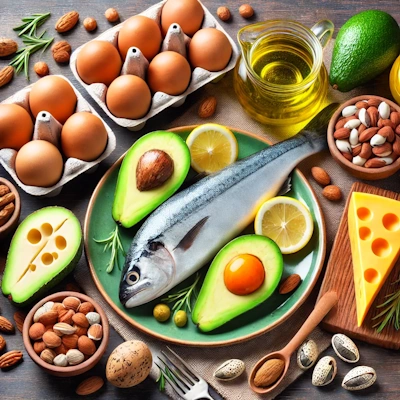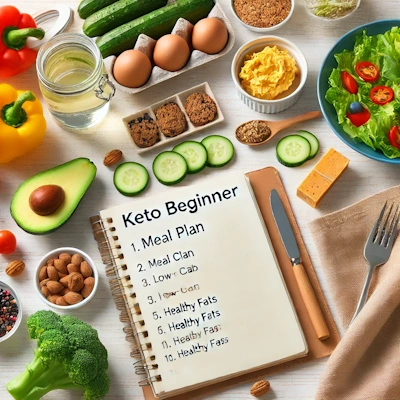Keto for Beginners: A Comprehensive Guide
Starting a new diet can be challenging, but with the right information, you can set yourself up for success. The ketogenic diet, or keto diet, is a popular low-carb, high-fat diet that has been shown to offer numerous health benefits. For beginners, it's essential to understand the basics to make the transition as smooth as possible.
The keto diet works by shifting your body's primary energy source from carbohydrates to fats. This process, known as ketosis, occurs when you significantly reduce your carb intake and increase your fat consumption. As a beginner, it's crucial to track your macronutrient intake to ensure you're eating the right amounts of fats, proteins, and carbs.
To start, focus on incorporating healthy fats like avocados, olive oil, and nuts into your meals. Avoid high-carb foods such as bread, pasta, and sugary snacks. Instead, opt for low-carb vegetables like spinach, kale, and broccoli. Remember, staying hydrated is vital, so drink plenty of water throughout the day.
Transitioning to a keto diet can be a learning curve, but with the right mindset and resources, you can enjoy its many benefits. Always consult with a healthcare professional before making any significant dietary changes.
Keto Diet Basics: What You Need to Know
The keto diet is a high-fat, low-carb eating plan that has gained popularity for its potential health benefits. Understanding the keto diet basics is essential for anyone considering this lifestyle change. At its core, the keto diet involves reducing carbohydrate intake to about 5-10% of your total daily calories and increasing fat intake to about 70-75%.
By drastically reducing carbs, your body enters a state called ketosis, where it burns fat for fuel instead of glucose. This can lead to weight loss, improved mental clarity, and increased energy levels. To get started, focus on high-fat foods like eggs, cheese, and fatty fish. Avoid grains, legumes, and sugary foods.
It's also important to monitor your protein intake. Consuming too much protein can interfere with ketosis, so aim for moderate amounts. A typical keto meal might include a piece of grilled salmon, a side of sautéed spinach, and a slice of avocado.
Staying informed and planning your meals in advance can help you stick to the keto diet. As you become more familiar with keto-friendly foods, it will become easier to make healthy choices that support your goals.

Starting Keto: Your First Steps
Starting keto can seem daunting, but breaking it down into manageable steps can make the process easier. The first step is to clean out your pantry and remove any high-carb foods that could tempt you. Replace them with keto-friendly options like nuts, seeds, and coconut oil.
Next, plan your meals for the week. Focus on incorporating a variety of low-carb vegetables, healthy fats, and quality proteins. Breakfast might include an omelet with cheese and spinach, while lunch could be a salad with grilled chicken and olive oil dressing.
When starting keto, it's common to experience the "keto flu" as your body adjusts to a lower carb intake. Symptoms can include fatigue, headaches, and irritability. To mitigate these effects, stay hydrated and consider increasing your intake of electrolytes through bone broth or supplements.
Remember, everyone's body is different, so it's essential to listen to your body and make adjustments as needed. With patience and persistence, starting keto can lead to lasting health benefits.
Beginner Keto Meal Plan: Getting Started
Creating a beginner keto meal plan is crucial for staying on track with your new diet. Start by selecting a variety of keto-friendly foods that you enjoy and can easily incorporate into your meals. Focus on whole, unprocessed foods to maximize the health benefits of the keto diet.
A typical day on a beginner keto meal plan might start with a breakfast of scrambled eggs cooked in butter with a side of bacon. For lunch, a salad with mixed greens, avocado, and a creamy dressing made with olive oil can be satisfying. Dinner could be a juicy steak with roasted Brussels sprouts and a dollop of garlic butter.
Snacks can include cheese sticks, almonds, or celery with peanut butter. It's essential to keep your meals varied to prevent boredom and ensure you're getting a range of nutrients. Additionally, meal prepping can save time and help you avoid the temptation of non-keto foods.
With a solid meal plan in place, you'll be better equipped to stick to your keto diet and achieve your health goals.

Keto Tips for Beginners: Staying on Track
Starting a keto diet can be overwhelming, but with these keto tips for beginners, you can stay on track and achieve your goals. First, familiarize yourself with keto-friendly foods and always have them on hand. This includes healthy fats, low-carb vegetables, and quality proteins.
Meal prepping is another essential tip. Prepare your meals in advance to avoid the temptation of reaching for high-carb options. Additionally, tracking your macronutrient intake can help ensure you're staying within your carb limits and getting enough fats and proteins.
Hydration is critical on the keto diet. Drink plenty of water and consider adding electrolytes to prevent dehydration and the "keto flu." Another useful tip is to join a keto community online or in person. Having support from others can provide motivation and helpful advice.
Lastly, be patient with yourself. Adjusting to a new way of eating takes time, and it's normal to experience some challenges along the way. With persistence and these keto tips for beginners, you'll be well on your way to reaping the benefits of the keto diet.
Discover the Ultimate Keto Diet Plan!


Keto Diet
Keto Coffee
Keto Lifestyle Embrace a Healthier You
Keto Hair Loss
Keto Meal Delivery Convenience and Health Combined
Keto and Heart Health Understanding the Connection
Need a temporary email? Check out our Trash-Mail Service for quick and easy email solutions.